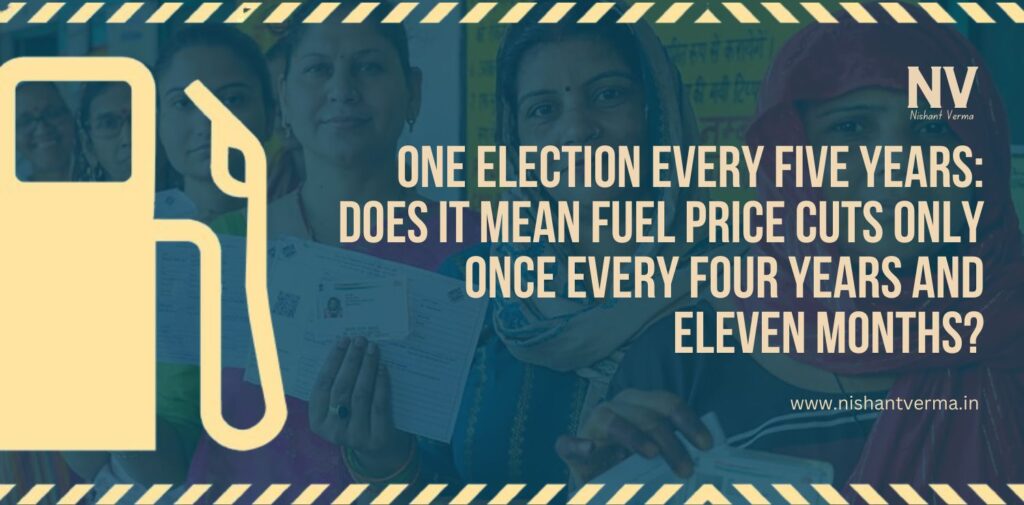In a democracy like India, elections are the heart of governance. Every five years, the nation gears up to cast its vote, determining which political party or leader will steer the country for the next half-decade. However, this electoral cycle often brings with it an uncanny pattern: a surge of politically motivated decisions designed to please voters. One such trend is the suspiciously timed reduction in fuel prices that tends to occur just before an election. It begs the question:
Are Indians destined to witness fuel price cuts only once every four years and eleven months?
The Politics of Fuel Prices
Fuel prices in India are a matter of daily concern for citizens. Petrol, diesel, and LPG are essential commodities that have a significant impact on household budgets, transport, and overall economic health. As these prices fluctuate with global oil markets, they also respond to taxes and duties imposed by the government, both at the central and state levels.

However, something interesting happens every election season: These prices seem to magically stabilize or even decrease, only to rise steadily once the ballots are cast. This phenomenon isn’t just a coincidence but reflects a political strategy embedded in the Indian electoral process. Fuel prices, being a highly sensitive issue for the middle class, become a pawn in the game of vote-bank politics.
Why Fuel Prices Matter to Voters
For the average Indian, fuel prices are not just numbers on a board at a petrol station. They directly affect daily life. From the cost of commuting to the price of essential goods, everything hinges on how much it costs to fill the tank. Therefore, when elections roll around, political parties become acutely aware of the public sentiment towards rising fuel costs.
By cutting these prices, parties in power often aim to soften discontent among voters, who might otherwise be disillusioned with the government’s economic policies. In essence, fuel price cuts are used to create an illusion of relief, making the ruling party appear as if it is addressing the common man’s woes, despite having largely ignored the issue for the previous four years and eleven months.
Election-Centric Governance: The Short-Term Fixes
The Indian political system tends to favor short-term measures over long-term solutions. Election season is when governments roll out populist policies in a bid to sway the electorate. These policies may include waiving off loans, increasing subsidies, launching welfare schemes, and, of course, reducing fuel prices. However, such measures often come at a cost. Once the election is over, the government frequently retracts these short-term benefits, and the focus shifts back to other priorities, leaving citizens to bear the brunt of rising prices.
This pattern raises a critical question about governance in India: are politicians more concerned with electoral gains than genuine economic reform? The manipulation of prices before elections seems to suggest that long-term planning takes a backseat to vote-winning tactics.
The Reality of Fuel Price Manipulation
Fuel price in India are determined by a combination of global oil prices and taxes levied by the government. When global crude oil prices drop, consumers expect the benefit to be passed on to them in the form of lower fuel prices. However, this doesn’t always happen. Instead, the government often increases excise duties or other taxes, absorbing the difference to fill its coffers.

Then, just before an election, the government might lower these taxes or cut the prices to appeal to voters. This strategy ensures that people experience short-term relief, which may influence their voting decisions. But once the election is over, prices often shoot up again, as the government looks to make up for the lost revenue.
For example, in the 2019 Lok Sabha elections, India saw a notable stabilization in prices in the months leading up to the polls. However, once the elections were over and the government was re-elected, fuel prices began to climb steadily, reaching new highs by 2020.
The Five-Year Election Cycle and Its Impact on Policy
The five-year election cycle is, by design, meant to ensure accountability and give the electorate a chance to choose their representatives. However, it has inadvertently created a system where politicians focus more on the immediate future—namely, the next election—than on long-term planning.

Fuel prices are just one aspect of this election-driven governance. The same pattern is visible in other sectors as well: infrastructure projects are inaugurated before elections, welfare schemes are launched, and benefits are handed out. Once the election is over, the pace of governance slows down, and the focus shifts from public welfare to managing the economy in ways that often benefit the government’s finances rather than the people.
Can Long-Term Economic Planning Ever Take Precedence?
The question remains: can India move beyond this election-centric model of governance, where policies are implemented with an eye on the next election rather than the long-term benefit of the country? For fuel prices, the solution may lie in delinking price adjustments from political considerations. Several experts have suggested that India adopt a transparent pricing mechanism for fuel, where prices are determined by global markets without government intervention. This could help reduce the politicization of prices of fuel and offer relief to citizens based on real economic factors rather than electoral timelines.
Additionally, focusing on long-term reforms in sectors like renewable energy could help India become less dependent on global oil markets, reducing the volatility of prices. Policies that encourage the adoption of electric vehicles, for example, could also lessen the economic burden of rising fuel costs on citizens.
How Political Parties Benefit from This Cycle
The manipulation of prices before elections is not just a tactic employed by one party; it’s a strategy that has been used by various governments over the years. Political parties understand that voters have short memories when it comes to economic pain. By cutting these prices just before the polls, they can create a temporary feel-good factor among the electorate, making people more likely to vote for the ruling party, even if the price cuts are superficial.
Moreover, this cycle of price manipulation has another advantage for political parties: it deflects attention from deeper economic issues. When fuel prices are cut, the immediate relief distracts voters from other pressing problems like unemployment, inflation, or agricultural distress. In a country as vast and diverse as India, managing public perception is a key part of electoral success, and fuel prices are an important tool in this game.
Conclusion: A Cycle of Short-Term Gains and Long-Term Pains
The pattern of reducing prices of fuel once every four years and eleven months, just before an election, is a symptom of a larger issue within Indian politics. The five-year election cycle has created a system where politicians prioritize short-term electoral gains over long-term economic planning. As a result, citizens are left to deal with rising fuel costs for most of the government’s tenure, with only brief periods of relief before elections.
For India to break free from this cycle, there needs to be a shift in how governance is approached. Transparency in fuel pricing, long-term energy reforms, and a focus on genuine economic policies rather than election-centric quick fixes are essential. Only then can the Indian electorate expect fuel prices, and other critical issues, to be managed in a way that benefits them in the long run, not just during election season.




